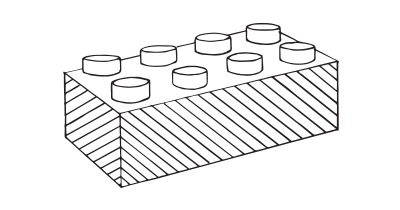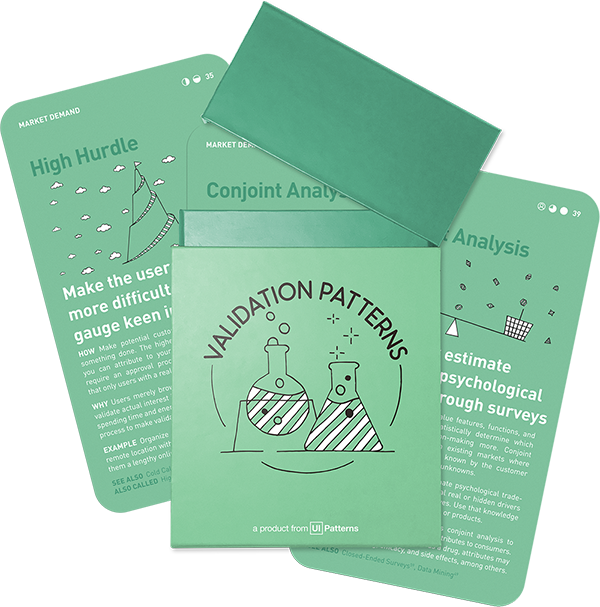See also: Clickable Prototype, Paper Prototype, Working Prototype
Difficulty: Easy
Evidence strength
Relevant metrics: Adaptiveness, Time to complete task, Customer feedback
Validates: Feasibility
How: Take advantage of Lego bricks' ubiquity and versatility to create quick and simple prototypes of your physical product that are easy to dismantle and tweak.
Why: Lego bricks can help you to quickly assemble a physical prototype that can give users an impression of form and function. Furthermore, Lego bricks allow for quick alterations making them an obvious prototyping tool for co-creation.
This experiment is part of the Validation Patterns printed card deck
A collection of 60 product experiments that will validate your idea in a matter of days, not months. They are regularly used by product builders at companies like Google, Facebook, Dropbox, and Amazon.
Get your deck!Before the experiment
The first thing to do when planning any kind of test or experiment, is to figure out what you want to test. To make critical assumptions explicit, fill out an experiment sheet as you prepare your test. We created a sample sheet for you to get started. Download the Experiment Sheet.
LEGOs serve as an ubiquitous toolkit
To create rapid prototypes, LEGOs versatility serve to create quick and simple prototypes. They are both quick and easy to build, but also to dismantle and tweak.
To create physical prototypes faster, prototype builders have begun to experiment combining 3D printing (slow to build) with LEGO pieces, so that 3D printing can be limited to only the part of the physical prototype that is undergoing test.
The advantage of using LEGO prototypes lies in their ability to quickly create physical models, which are much faster than most 3D printers. They are relatively inexpensive for creating prototypes of products that are physical and tangible. Moreover, LEGO prototypes are versatile and can be easily modified, which is beneficial in the exploratory stages of product development.
However, LEGO prototypes have limitations, such as not being suitable for digital products like mobile apps or websites. They can also be more expensive compared to other low-fidelity prototypes if you don’t already have a set of LEGO bricks.
LEGO Serious Play
In the broader context of business and design thinking, LEGO bricks are often used as a tool for facilitating creativity, communication, and collaboration. LEGO Serious Play, for instance, is a methodology used in workshops and team-building exercises, where participants use LEGO bricks to build models that represent their ideas, strategies, or business challenges. This approach has been adopted by a range of organizations, from small businesses to large corporations, as a way to foster innovation and teamwork.
Additionally, in the field of product design and development, LEGO bricks can be used as a quick and accessible way to build physical prototypes. This approach is especially useful in the early stages of the design process, where the focus is on exploring concepts and testing basic functionality rather than on creating a polished final product.
After the experiment
To make sure you move forward, it is a good idea to systematically record your the insights you learned and what actions or decisions follow. We created a sample Learning Sheet, that will help you capture insights in the process of turning your product ideas successful. Download the Learning Sheet.
Examples
3D printing combined with Legos
Waiting 5 hours for a 3D printer to be done can sometimes be too long. This is why prototype professionals are beginning to swap the parts of your 3D print that you don’t need printed, with blocks of LEGO to make rapid prototyping even faster by minimizing the components that needs to come from a 3D printer.
Source: Replacing Parts of 3D-Printed Models With Lego Speeds Up Prototyping
IDEO insulin injection
IDEO used Lego bricks to create multiple prototypes for complex insulin injection devices before even starting to think about real production.
Related plays
- Prototyping: Learn Eight Common Methods and Best Practices by Rikke Dam & Ted Siang
- Replacing Parts of 3D-Printed Models With Lego Speeds Up Prototyping by Andrew Liszewski

